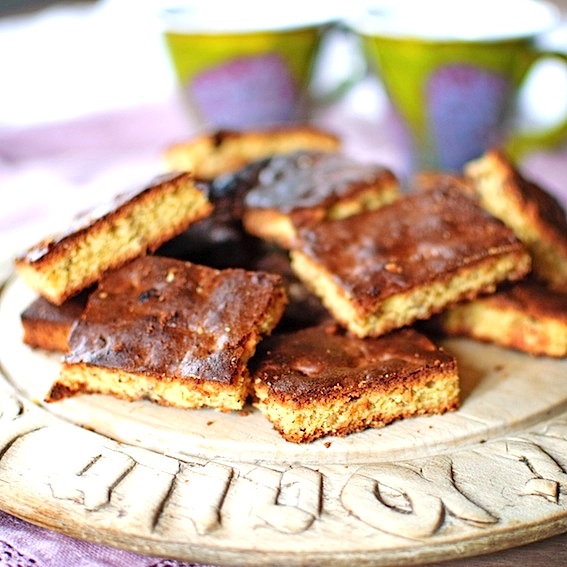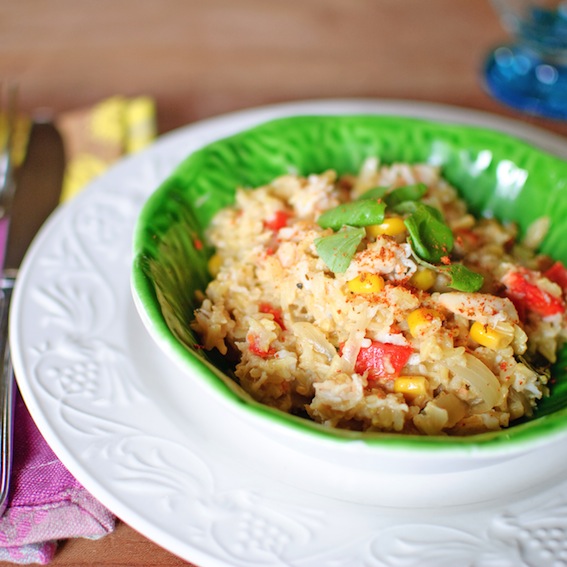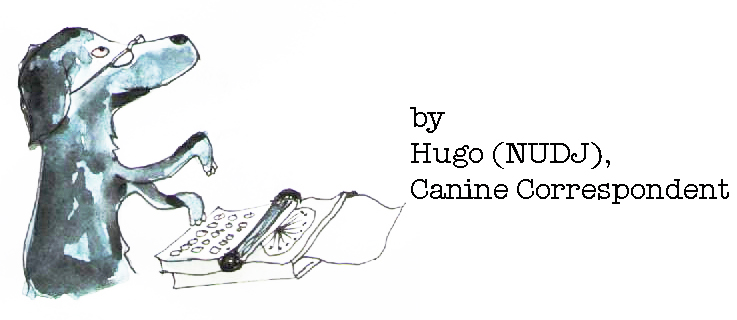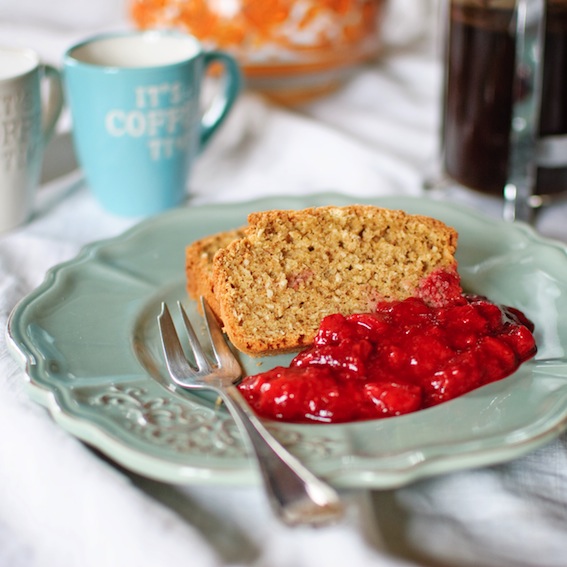-
Crab gratin and if it looks like a dog and barks like a dog…
…but eats like a human, then it’s probably Hugo.

I’m in splendid shape, but every year Bossy insists on taking me to visit the vet. She knows that I’m a force to be reckoned with when it comes to socialising with other animals, but she seems adamant on putting herself through the trauma. Upon arrival, I willingly led her – perhaps even dragged her if I’m entirely honest – to the door, which I only had to headbutt once to open. I then efficiently ushered her (again, if we’re being pedantic, ‘hauled her’ might be more accurate) to the reception desk, where I planted my front paws on the desk in a business-like manner. By this time, for some reason, Bossy was very red in the face. The vet is a nice lady and I gave her a big lick on the face to show that I felt no ill will towards her, even though she spent rather a long time prodding my private parts. When we were ready to leave, she told me that I had been a good boy (yeah, whatever) and gave me a dog biscuit. I mean, really? A dog biscuit? Who does she think I am? Camembert? Yes. Foie Gras? Yes. Dog biscuit? Err, not so much. Does she not know that I’m a foodie? Anyway, I spat it out onto the floor because I think it must have been a joke. Bossy by this time was even redder in the face and really quite flustered and tried to explain that I was off my food. What a liar! I’m not off normal food, just dog biscuits…
Ingredients (serves 4)
250g new potatoes, peeled, sliced and cooked
2 leeks, sliced and cooked
250g crabmeat (I used tinned)
150g sweetcorn
1 large spring onion, finely sliced
150ml pouring cream
Sea salt and freshly-ground black pepper
1 teaspoon chilli powder (optional)
100g hard cheese, grated (I used Comté)
Fresh parsley to garnish
Preheat the grill. Place the potatoes, leeks, crabmeat, sweetcorn and onion together in an oven-proof dish and then add the cream and seasoning. Mix well and sprinkle the grated cheese on top. Cook under the grill until the cheese is bubbling and golden (about eight minutes). Garnish with the fresh parsley before serving. -
Ratatouille and pride and prejudice

To start with, pride: Léo won his singles tennis match and his team were runners up in the tournament finals on Sunday, winning a silver cup for their valiant efforts. Had there been a cup for mothers who, against all odds, almost manage to keep their mouths shut, it would certainly have gone to me. The only thing to pass my lips was a discreet ‘make him run – he’s heavy’ (oh the shame!). It appears that I’m not the only one to suffer from Tournament Tourettes though; one boy’s mother was escorted off the court by an official for her loud and unsolicited ‘advice’ and ‘support’. Can you imagine? The cheek of the woman…
On to prejudice: Java keeps presenting me with her own prizes – body parts of a dead rabbit. So far today, I’ve been offered two legs (separately) and the head. She’s obviously just a dog doing doggie things, but instead of congratulating her on her hunting prowess, I am overcome by human bigotry and flee, screaming instructions (sensing a theme here?) at Luc to get rid of anything in the vicinity that is furry and dead. I might have to seek Hugo’s advice on how best to broach this with Java.
The word ratatouille comes from ‘touiller’, which means to stir or mix and the recipe originates from Nice in the South of France. There are many different versions, and I prefer mine to be light on tomato, heavy on red onion and garlic and cooked al dente.
Ingredients (serves 4)
100ml olive oil
1 red onion, chopped
2 spring onions, sliced
4 cloves of garlic, crushed
2 tomatoes, peeled and roughly chopped
1 red pepper, sliced
1 fennel, sliced
1 large courgette, peeled and cut into cubes
Sea salt and freshly ground black pepper
½ teaspoon Espelette pepper or paprika
Parsley or basil leaves to garnish
Heat the olive oil over a medium heat in a large cast iron pan. Add the onions and garlic and heat until softened. Add the tomato, pepper, fennel, courgette and seasoning, cover and leave to simmer over a medium heat, stirring occasionally for about 20 minutes or until the vegetables are softened, but not overcooked. Add the garnish before serving. -
The emperor’s cakes (gateaux de l’empereur) and a loud-mouthed mother

It’s tennis tournament time again and, despite my best efforts, my perennial Tournament Tourettes has kicked in with a vengeance. As yet, I have been unable to locate a suitably effective gag for myself but, if I find one, I will be sure to buy a couple because there have been a few occasions when also gagging the opponent’s parents would have been advantageous. I admit that it’s not really fair play to yell ‘leave it – it’s going out’ or ‘yesssss!’ as Léo’s poor opponent hits the ball into the net, but one glimpse of fluorescent yellow balls and apparently I become one of Those Mothers. Despite, or perhaps thanks to, my ‘help’, Léo is through to the finals which are to be played on Sunday when, to the delight of all and sundry, I predict my Tennis Tournament Tourettes will reach a resounding crescendo. Due to a pitiful lack of gag shops around here, I can only keep my fingers crossed for a debilitating case of laryngitis…
These French delicacies (Gateaux de l’Empereur) are a cross between a biscuit and a cake. Apparently they were originally made for a banquet given in honour of Charles IV. There are many different variations.
Ingredients
4 eggs
250g cane sugar
250g powdered almonds (or powdered hazelnuts)
250g raisins
250g spelt flour
1 teaspoon baking powder
Preheat the oven to 180°C. Prepare a baking tray by covering with greaseproof paper. Beat the eggs and sugar together until pale. Combine the almonds, raisins, flour and baking powder in a separate bowl and gradually add to the egg/sugar mixture to obtain an thick paste. Spread over the greaseproof paper on the baking tray and bake for 25 minutes. Cut into squares while still warm. Keeps in an airtight tin for several weeks. -
Chocolate

Chocolate
Velvet fruit, exquisite square
I hold up to sniff
between finger and thumb –
how you numb me
with your rich attentions!
If I don’t eat you quickly,
you’ll melt in my palm.
Pleasure seeker, if i let you
you’d liquefy everywhere.
Knotted smoke, dark punch
of earth and night and leaf,
for a taste of you
any woman would gladly
crumble to ruin.
Enough chatter: I am ready
to fall in love!Rita Dove 2004
Perhaps unsurprisingly, the botanical name for cocoa, the raw ingredient used to make chocolate – Theobroma Cacao – means ‘Food of the Gods’.
In addition to being extremely delicious, cocoa boasts over 1,500 active phytochemicals, making it one of the most nutrient-rich foods in the world. Eating a small amount of dark chocolate (minimum 70% cocoa solids) every day is a luxurious and palatable way to improve your overall health. By weight, Cacao has more antioxidants than red wine, blueberries, acai, pomegranates, and goji berries combined.
Cocoa is a very rich source of minerals. It is the number one source of magnesium, of which roughly 80% of the population have a chronic deficiency. Magnesium helps burn fat to produce energy, aids in fighting depression, promotes a healthy cardiovascular system, prevents muscle spasms, keeps bones and teeth healthy and acts as a natural tranquilliser. Cocoa also contains iron and manganese, both vital for the production of haemoglobin and proper oxygenation of the blood. It contains chromium too, a trace mineral important for detoxification and the correct regulation of blood sugar. Cocoa is also a rich source of zinc, which is important for the proper functioning of the immune system, the liver, pancreas and skin.
Chocolate is good for the heart and circulation. The polyphenols protect the heart by inhibiting blood platelets from clumping together, which can lead to a hardening of the arteries. A recent study also found that dark chocolate can help restore flexibility to the arteries. And researchers in Finland discovered that chocolate consumption lowers the risk of suffering a stroke by 17%.A small square of good-quality chocolate melted on the tongue 20 minutes before a meal triggers the hormones in the brain that say ‘I’m full’, potentially aiding weight loss. Finishing a meal with the same trigger could conceivably reduce the desire to eat between meals. In addition to this, cocoa has been shown to reduce insulin sensitivity, which in turn may prevent the onset of diabetes.Chocolate is beneficial for the brain. Flavanols reduce memory loss in older people, by stimulating blood flow in the hippocampus, the area of the brain associated with learning and memory. Cocoa also contains two compounds that have a significant effect on brain chemistry: The first is anandamide, which evokes euphoria and clear, creative thinking; the second is phenylethylamine, a neurotransmitter linked to mood elevation and improved focus.
So buy the best quality chocolate with the highest cocoa content you can find and enjoy with moderation. You can also use pure, raw cocoa powder with no added sugar to make deliciously nutritious cakes, mousses and other sweet treats. -
Coconut crab risotto and bathroom devotion

Admittedly an unfortunate juxtaposition for my risotto, but I spent today mixing concrete. Never let it be said that I don’t lead a glamorous life. For the uninitiated amongst you, cement mixing is not dissimilar to mixing a very large cake, which I suppose doesn’t say much for my cakes. It’s very therapeutic though, concrete; I now better understand Winston Churchill’s passion for building walls. There was a bit of a low point this morning when I tripped and fell flat on my face, leaving 25kg of sloppy concrete mix to ooze in my wake, but other than that I think I did quite well. Although I’m obviously no expert, one top tip would be to keep the dogs well out of the way, because they will be tempted to come and ‘help’:

We’re in the process of building another bathroom – my husband is a big fan; adding on bathrooms is a hobby of his. If publications such as ‘Bathroom Weekly’ or ‘Faucets and Drains Today’ existed, he would certainly subscribe. In our previous house, last count, we had ten bathrooms. This is why we had to sell really – we had exhausted its bathroom potential. We’ve been in our present house for seven years and are now on our fourth. Hopefully we won’t break through the bathroom ceiling any time soon though because I like it here…
This is a recipe for a quick, easy but nonetheless delicious risotto. It never fails to please. And if ever you need advice on mixing cement, I’m your girl.
Ingredients (serves 4)
2 tablespoons coconut oil
3 shallots, finely chopped
1 red pepper, sliced and chopped
2 cloves of garlic, crushed
1 teaspoon of fresh ginger, grated
280g rice (I used whole basmati)
120ml white wine
700ml chicken or vegetable stock
Sea salt and freshly-ground black pepper
1 teaspoon chilli powder
150g sweetcorn
200ml coconut milk
300g tinned crabmeat
Handful of fresh basil, shredded
Heat the oil in large pan over a low heat, add the shallots and cook for five minutes until softened. Add the pepper, garlic and ginger and cook a little more. Add the rice and stir until it’s well coated with oil. Pour in the wine, stirring until all the liquid has been absorbed. Add the stock little by little and stir until almost completely absorbed. Repeat this process, adding the stock a ladle at a time, stirring constantly until all the stock has been used up (about 20 minutes). Add the seasoning and you can add more water if the rice isn’t cooked (this will be the case if you’re using whole basmati, as I did). Add the sweetcorn and coconut milk, stirring until the coconut milk absorbs. Add the crabmeat, cover and leave to heat through for about five minutes. Add the shredded basil to serve. -
Vegetable fritters (gf) and visually-challenged Setters


I think that Java needs glasses. Either that or a new brain, but I’m going to be charitable and go with the glasses theory. (As an aside, she also needs to learn which holes she can and can’t stick her nose into, because it’s looking a bit mangled at the moment. Still, we can’t all be hole experts.) Even allowing for the fact that she’s not the brightest, I’ve noticed her a few times recently rather proudly ‘marking’ plastic bags. I know plastic bags can flap in the wind a bit and do very fine bird imitations, but still: Really Java? You’re a dog with a supposedly superior sense of smell. I’m not sure how to broach the subject with her though; it’s a tricky one. Apparently English Setters are extremely sensitive to criticism, and I wouldn’t want to be responsible for tipping her over the edge by pointing out her mistake, tempted though I might be. I think I’ll just leave it to Bossy and her finely-tuned diplomacy skills to explain her error. Watch this space for one horribly humiliated English Setter *wicked dog chuckle*.
Ingredients (serves 4)
2 eggs, beaten
75g chickpea flour (although any flour will work)
½ teaspoon bicarbonate of soda
125ml water
1 potato, peeled and grated
2 courgettes, peeled and grated
1 carrot, peeled and grated
1 onion, finely chopped
1 clove garlic, crushed
4 leaves fresh mint, cut into strips
Sea salt and freshly ground black pepper
1 teaspoon curry powder
1 tablespoon of ghee for frying (you can use butter or oil)
Combine the beaten eggs, flour and bicarbonate of soda, gradually adding about 125ml of water to achieve a fairly thick pancake batter consistency. Add the grated vegetables, onion, garlic, fresh mint and seasoning and combine well, making sure that the vegetables are well incorporated. Heat the ghee in a large frying pan over a medium heat until melted and create several two tablespoon-sized fritters. Fry until golden brown (roughly 5 minutes), turn and repeat until all the fritters are cooked. -
Coconut cake and Hugo’s scuppered plans


I would like to set the record straight about my recent excavation venture, because I thought that Bossy portrayed me as a bit of a halfwit by suggesting that I was stuck down my magnificent hole. I admit that I did let her haul me out with a rope (there was lots of swearing on her part), but only to shut her up. The plan was, once I’d finished what I’d set out to do (we won’t go into details to spare any squeamish readers), I was going to create a tunnel back to the top at a gradient of about 30%. Of course, this would have taken quite a long time and I’m not sure where I would have ended up, but anything that gets me away from Bossy’s incessant blabbering and Java’s stubborn insubordination can only be a good thing. As an aside, are you impressed at how my vocabulary is becoming more and more sophisticated? Bossy says that I must be careful to avoid becoming too verbose, although she’s a fine one to talk. Anyway, the upside was, she was so convinced that I had been traumatised by my adventure, when we got home she gave me an extra-large piece of camembert. Sometimes it pays to just go with the flow…
Thank you Hugo for telling your side of the story, although I think we could have done without the reference to my ‘blabbering’! This wonderfully light cake is inspired by ‘Love, bake, nourish’.
Ingredients (serves 8-10)
175g spelt flour
120g desiccated coconut
1 teaspoon baking powder
½ teaspoon bicarbonate of soda
75g cane sugar
1 egg, beaten
200ml coconut milk
1 teaspoon vanilla extract
Preheat the oven to 180°C. Grease and prepare a medium-sized loaf tin. Combine the flour, coconut, baking powder, bicarbonate of soda and sugar in a large bowl and then add the egg, coconut milk and vanilla extract. Mix thoroughly and transfer into the prepared tin. Bake for about 35 minutes, or until a skewer inserted into the centre comes out clean. Leave to cool and serve with strawberry coulis or Greek yoghurt (or both!). -
Chicken with bacon and white wine and the latest dog horseplay

As I have absolutely no wish to linger on last weekend and Léo’s ‘totally cool skis that go backwards as well as forwards’ (this, according to the man in the rental shop, was a selling point), I’m going to talk about the dogs and their latest antics. Hugo and Java are a generation apart in dog years. While Hugo certainly isn’t averse to a bit of television (Scooby Doo being his favourite), he doesn’t really ‘do’ computers. Java does, and she apparently has strong opinions on graphics; yesterday she took unusual and hysterical exception to the screensaver that Léo had installed. I don’t blame her really – it was a sort of Grufallo monster menacingly yielding a leg of lamb. Anyway, she was ear-splittingly inconsolable until the offending image was replaced with something more serene. Meanwhile, Hugo was outside digging the World’s Biggest Hole. He was gone a couple of hours and, after frantic searching, I found him stranded 2m below ground level, covered in mud and sand trying to ‘liberate’ an unidentified, and no doubt petrified, small animal. He looked quite relieved to see me and my sturdy rope because I think he realised there was no way he was getting out on his own. In future Hugo: When you’re in a hole, stop digging!
This dish is quick and easy to make, but no less delicious for it. It is adapted from ‘Nigella Express’.
Ingredients (serves 4)
1 tablespoon olive oil
1 leek, washed and cut both ways
1 onion, chopped
4 mushrooms, sliced
4 rashers bacon
4 chicken escalopes (approx. 125g each)
100ml white wine
Sea salt and freshly ground black pepper to taste
Put the olive oil in the frying pan and heat. Add the leek, onion, mushrooms and bacon and fry until the bacon is crisp. Remove the bacon and set aside. Fry the chicken until cooked through (a couple of minutes on each side). Put the bacon back into the pan, add the wine and cook until the wine bubbles. Season to taste and serve with rice and a salad or green beans. -
A handful of salt

Salt is essential to life. Sodium is one of the seven macrominerals (along with calcium, chloride, magnesium, phosphorus, potassium and sulphur) and is used for a multitude of biochemical processes such as fluid and acid-alkaline balance and electrical signaling in the nervous system. It is also necessary for adrenal gland function.
All salts are mainly made up of sodium chloride. Table salt is manufactured by cooking to 1200°F, which removes the other trace minerals. Chemicals and anti-caking agents are then added and it is bleached to make it white. This type of salt has almost no benefits and plenty of drawbacks; in many cases it is positively toxic, causing high blood pressure, kidney problems and impaired muscle and nerve function. It should be avoided at all costs.
While sea salt is a far better option than table salt because the other minerals are still present, sea pollution means that producers are having to refine their products, meaning that some of the natural goodness is taken away. Probably the purest sea salt available is from the salt marshes in Brittany where it is still produced using ancient methods.
My favourite salt is Himalayan crystal salt. Not only is it a pretty pink colour (shallow? Moi?), it contains 84 minerals and trace elements in ionic state, meaning that they are tiny enough for the body’s cells to absorb them easily. Its benefits include :- Water regulation
- Healthy pH balance
- Healthy blood sugar
- Generation of hydroelectric energy in the cells
- Food and nutrient absorption
- Respiratory health
- Prevention of muscle cramps
- Sleep and relaxation
- Blood pressure regulation
Not only is Himalayan salt an excellent choice for use in the kitchen, a few handfuls added to warm (but not hot) water makes a wonderfully relaxing and detoxifying bath. Soaking in a Himalayan salt bath provides an effective treatment for dry skin and psoriasis, soothes insect bites and relieves muscle pain or cramping, as well as easing arthritis. Finally, it reduces stress and promotes a good night’s sleep.
-
Pear cake and an exhausting email exchange

I engaged in a slightly surreal email exchange with a ski instructor recently. I wanted to reserve a skiing lesson for Léo for this weekend – a lesson in which he would hopefully learn a) how to leave the other mountain users vertical and intact, and b) that posts, signs (particularly ones that say ‘slow down’) and barriers are there for reasons other than to be uprooted while flying past. I asked for a one hour private lesson on Monday morning, Mr Ski Genius replied that he could offer a two hour lesson on Sunday afternoon. So I enquired about a two hour lesson on Monday afternoon, which he was afraid he couldn’t do, but he could perhaps fit in a one hour lesson on Sunday morning, assuming that I was the person that had originally wanted to book for Tuesday afternoon. There were numerous other variants discussed far too tortuous to go in to, including, if I remember correctly, the possibility of a one and a quarter hour lesson from midnight on Sunday, which was obviously very tempting. Anyway, the upshot is that I lost the will to live and conceded defeat. We’re just going to wing it and give him a call when we get there to try to arrange (although frankly, the thought of a ‘phone conversation with him brings me out in a cold sweat). I just hope that his lessons are less convoluted than his emails. Failing that, we can pray that the other skiers and signposts are more robust than last time. It could all prove to be very interesting…
I bought a variation of this ‘moelleux aux poires’ in a patisserie when we were last skiing. Anything tastes good after a day on the slopes, particularly with Léo, but this was still delicious when I made it at home.
Ingredients
3 pears, cut into eight
1 tablespoon rum
1 vanilla pod
100g cane sugar
50g butter
50g coconut oil
3 eggs
75g rye flour
75g buckwheat flour
50g powdered almonds
1 teaspoon baking powder
1 teaspoon bicarbonate of soda
Preheat the oven to 180°C. Poach the pears in a little water with the rum and vanilla pod. Blend the butter, coconut oil and sugar until fluffy. Add the eggs one by one, and then the flour, baking powder, bicarbonate of soda and almonds and combine well. Add the drained, poached pears and gently incorporate into the mixture. Transfer to a pre-buttered medium-size loaf tin and bake for 30 minutes, or until a skewer inserted into the centre comes out clean.
